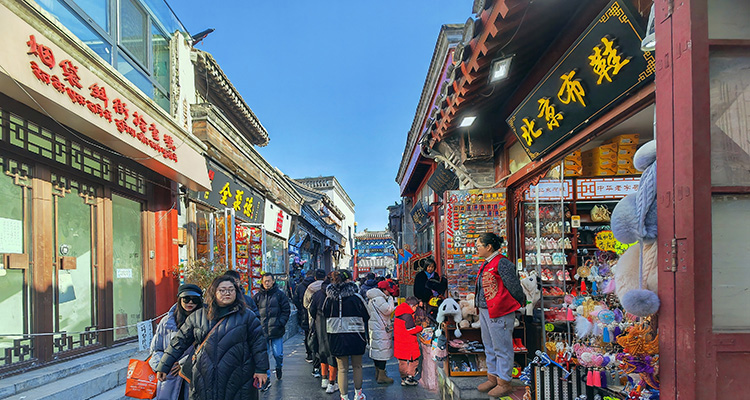Beijing Hutongs: A Journey Through Time
1. What Are Beijing Hutongs? — The Heart of Old Beijing
When you first wander through Beijing Hutongs, you’re stepping into a living museum of the city’s past. These ancient lanes—narrow, quiet, yet full of life—form the old soul of Beijing. Unlike the city’s high-rises and modern malls, hutongs are built from gray bricks, curved rooftops, and time-worn courtyards that whisper stories of centuries gone by.
A stroll here is more than sightseeing—it’s sensory immersion. You hear the ring of bicycle bells, smell fresh dumplings and roasted chestnuts, and hear locals chatting outside courtyard gates. It feels as if time has slowed down just for you. These historic neighborhoods capture a rhythm of life that has barely changed for generations.

2. The Story Behind the Lanes — History and Meaning
The origins of Beijing’s hutong system trace back to the Yuan Dynasty (around the 13th century). Designed as part of the city’s early grid plan, the old alleyways connected noble mansions, temples, and ordinary homes. During the Ming and Qing dynasties, hutongs became the beating heart of local communities—where people lived side by side, families grew, and stories unfolded.
Each historic alley holds fragments of Beijing’s social memory. Within these traditional neighborhoods, life was simple yet vibrant: neighbors looked out for each other, families shared meals across generations, and artisans practiced their crafts in open courtyards. The hutong’s spirit lies in that sense of togetherness—a reflection of the Chinese idea of harmony and family unity.

3. How They Were Built — Architecture and Craftsmanship
Traditional courtyard homes (siheyuan) are the signature feature of Beijing hutongs. Built mainly from brick, wood, and stone, they use classic joinery techniques—mortise and tenon—instead of nails. Builders carefully designed each home to balance privacy, airflow, and sunlight, following the principles of Feng Shui.
Every Beijing alley tells a story through its materials and design. Stone doorbases carved with lions guard the entrances. Brick reliefs and calligraphic plaques express the family’s wishes for luck and longevity. Even plants add personality—climbing vines in summer, chrysanthemums in autumn, plum blossoms in winter.
The result is an open-air artwork of architecture and daily life. The alleys aren’t just streets—they’re stages where life unfolds: peddlers selling steamed buns, craftsmen repairing bicycles, and children playing under old parasol trees. Together, they form a portrait of authentic Beijing life that no skyscraper can replace.

4. Experiencing Hutongs — Walk, Ride, Taste, and Talk
To truly appreciate Beijing Hutongs, slow down. Notice how the light falls across the gray walls, how red lanterns sway gently at dusk, and how the smell of jasmine tea drifts from a courtyard.
You can explore these old alleyways on foot or by bicycle—each turn reveals a new scene. Stop to try local street snacks like bao du (boiled tripe) or douzhi (fermented soy drink). Sit with locals playing chess or join a morning Tai Chi session in a small square. These moments are what make the authentic hutong experience unforgettable.
Talking to residents is the best way to connect. Many families have lived here for generations and love sharing tales about the area’s history, festivals, and changes over time. Through them, you see how traditional neighborhoods adapt and survive in a modern city.

5. Where to Explore — Best Hutongs to Visit in Beijing
While modernization has replaced some historic alleys, many have been carefully preserved, allowing travelers to glimpse authentic old Beijing. Here are the top places to explore:
- Shichahai — a peaceful area near the lakes, lined with willow trees and classic courtyards. Perfect for photography and slow walks.
- Nanluoguxiang — lively, artistic, and trendy, with cafés, boutiques, and galleries tucked into narrow lanes.
- Yandaixiejie — an older, slanted street famous for antiques, tea houses, and traditional crafts.
For a deeper understanding, join a hutong tour with local guides who can explain the symbolism behind courtyard architecture or take you inside private homes. You can also visit the Beijing Hutong Museum or join cultural workshops like paper-cutting, calligraphy, or dumpling-making in courtyard homes.
Each alley offers something different—some quiet and reflective, others vibrant and full of modern art. Together, they form a living network that bridges old Beijing lanes with the city’s evolving future.

6. Why They Matter — The Spirit of Beijing Hutongs
Hutongs aren’t just relics of the past—they’re reminders of a lifestyle rooted in connection, craftsmanship, and simplicity. They represent what makes Beijing local life special: the warmth of human contact, the harmony of tradition and change, and the rhythm of everyday moments.
Exploring these historic neighborhoods gives travelers more than photographs—it gives perspective. It reminds us that a city’s true beauty lies not only in its monuments, but in the laughter echoing down a quiet lane, the aroma of dinner from a courtyard, and the way history lingers in every wall crack and tile.

7. Final Thoughts — Walk Into the Living History of Beijing
So next time you’re in Beijing, step away from the skyscrapers and wander into the hutongs. Let curiosity guide you down narrow paths, pause to watch a craftsman carve wood, or share a cup of tea with a local storyteller.
These Beijing Hutongs are not just alleys—they are time capsules, connecting past and present in every turn. Each visit feels like walking through a living heartbeat of the city. By the time you leave, you’ll carry a piece of Beijing’s soul with you—a memory of warmth, simplicity, and timeless charm.


